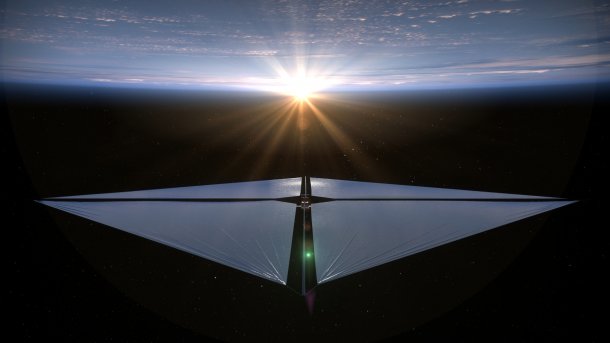Successful launch: NASA satellite to test 80 m² solar sail
NASA has launched a satellite that should once again prove the efficiency of solar sails. It could soon be visible from Earth.

This is what the satellite should look like unfolded
(Bild: NASA/Aero Animation/Ben Schweighart)
A NASA mission to test solar sails in space has been successfully launched, with the satellite undocking in Earth orbit after launch on a Rocket Lab rocket. The US space agency announced this and added that it is now waiting for the Advanced Composite Solar Sail System to activate and contact the ground station.
A two-month preparation period will then begin, during which the satellite, which is the size of a microwave oven, will also deploy its four solar sails. Weeks of tests are then planned, during which the satellite will only change its orbit thanks to the extremely weak pressure from the sunlight. This is equivalent to the pressure exerted by a paper clip resting on a hand.
Much larger sails possible
Under the right lighting conditions, the satellite may also be visible from Earth, NASA also announced. Thanks to the reflections on the large solar sails, it can appear as bright on the Earth's surface as Sirius, the brightest star at night. With this mission, NASA not only wants to prove once again that solar sails are an alternative way to propel spacecraft. A new method of deploying the huge sail is also to be tested. This consists of four parts that are stretched out on cross-shaped brackets.
Once unfolded, the solar sails of the Advanced Composite Solar Sail System have a total surface area of 80 m², writes the US space agency. The seven-meter-long holders are folded up so small that they take up no more space than a hand. The technology should already work for a solar sail with a surface area of 500 m², and if successful, the mission should also make it possible to deploy solar sails with a surface area of 2000 m².
Solar sails have been discussed for decades as an alternative to existing forms of propulsion for spaceships. Attached to the immense sails, they are to be propelled solely by the radiation pressure of the sun - or strong lasers. Although this is not powerful, it should be able to accelerate spaceships to immense speeds over longer periods of time. The concept has recently gained momentum because the Israeli-Russian billionaire Yuri Milner is working on using this technology to send spaceships to our neighboring star Alpha Centauri in large numbers and in a comparatively short time. An experimental satellite of the Planetary Society has proven the viability of the concept in a three-year test lasting until 2022, and now NASA is following suit.
(mho)